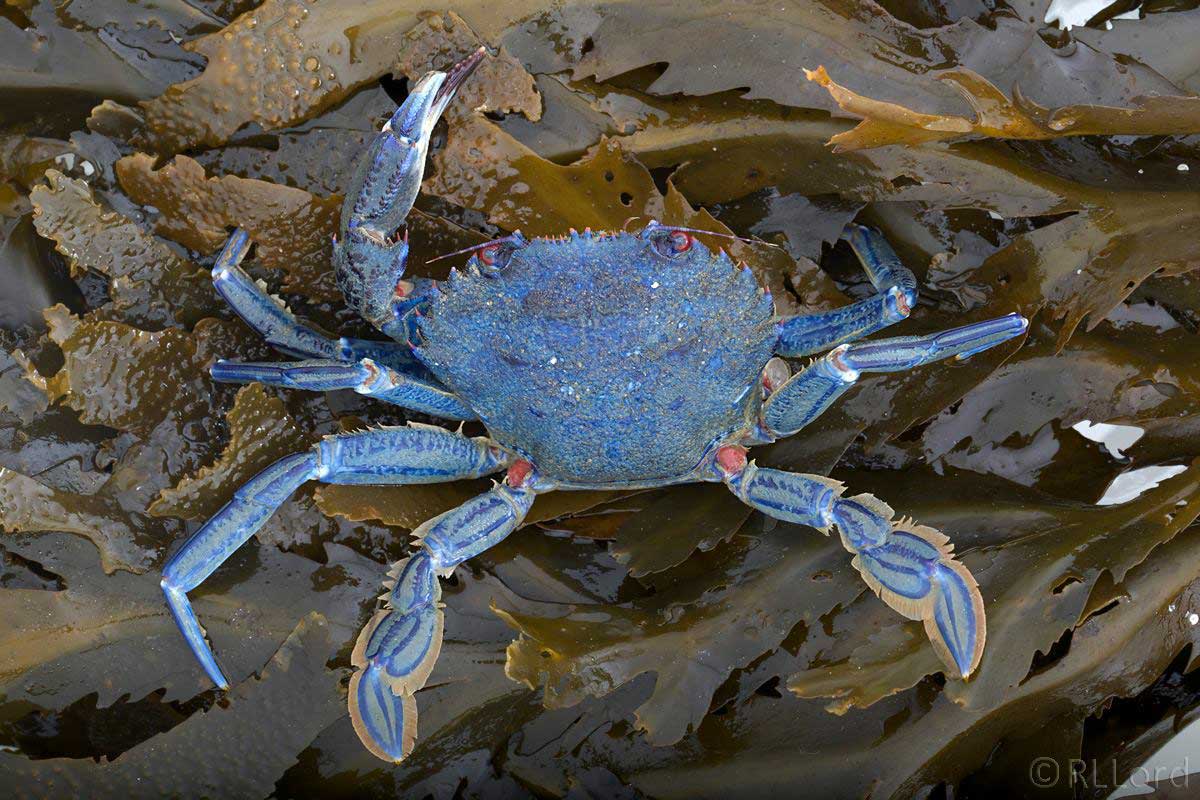Identification:
Photographs:

Medium sized. Carapace broader
than it is long. Two powerful claws. Rear legs rounded.
Colour:
Similar
species:
Breeding:
Habitat:
Food:
Range:
All British coasts.
5 December
2014

Blue
Velvet Swimming Crab (=Lady Crab), Necora puber
Photograph
by Richard Lord
Sealord
Photography
Shane
Huxter found a blue-coloured Velvet
Swimming Crab (Lady Crab in Guernsey),
Necora
puber, in Belle
Greve Bay, on the east coast of Guernsey. The
shell colour of Necora puber
is normally blue but the crab is usually covered in a fine brown 'hair'
which gives it an olive-green colour. This individual's bright blue shell
colour might be a genetic variation to the normal colour.
6
January 2011
A
mass stranding of crabs occurred on the Isle
of Thanet
coast, Kent; about 40,000 Velvet Swimming Crabs,
Necora
puber, were discovered on the strandline
amongst lesser numbers of molluscs, sea
anemones, sponges and other washed up invertebrates.
The
most likely reason for this mass death was hypothermia.
13
January 2010
A
mass stranding of crabs occurred on the Isle
of Thanet
coast, Kent; the crabs have been reported on beaches
at Westbrook, Cliftonville
and Kingsgate,
while smaller numbers have been washed up between Broadstairs
and Ramsgate. Most
of the crabs were the Velvet Swimming Crab,
Necora
puber, which inhabits the shallow seas beneath
the intertidal zone, over rocky substrates.
.
A
bright blue specimen of the Velvet Swimming
Crab, Necora puber, was collected
by a diver at Thatcher's
Rock, Torbay, Devon in the spring of 1998.
Also a bright red specimen of this swimming crab was collected by Jon Makeham
from the shore at Looe
in October 1998.
Bionomics:
Enemies: anything
that can swallow it, depending on size and location.
Additional
Notes:
Why
do crabs walk sideways?
Moulting
cycle in Crustacea
Largest
Crabs
Western
Morning News - Thursday, July 21, 2011
A giant
crab more than three times heavier and almost twice as big as normal has
emerged
from the deep after being caught by a Westcountry fisherman.
The
velvet swimming crab – also known as a devil or witch crab – was caught
by
Mylor
fisherman Ned Bailey in a crab pot about a quarter of a mile south east
of
St
Anthony Lighthouse in Falmouth Bay, Cornwall.
Normal
specimens usually weigh around 90 grams or 3.2 ounces, with a shell that
measures
six centimetres – 2.4 inches – across.
However
this crab tips the scales at a whopping 268 grams or 9.5 ounces and is
more
than 10 cm or 4 in across.
It
has been donated to Newquay's Blue Reef Aquarium. Blue Reef curator Matt
Slater
said: "We're still not sure that he's the biggest ever caught in the UK
but
he's certainly the largest anyone here has ever seen and he's significantly
heavier
and longer than anything we can find in our reference books.
"A
crustacean's size and weight are all due to a number of different factors
including
diet, environment and even water temperature.
"It
may also be that this is a particularly old individual but even taking
all
those
factors into account he really is a bit of a monster – and very feisty
with
it," he added.
They
get their name from the dense, velvety hair on their shells.
http://www.thisiscornwall.co.uk/Giant-deep-captured-fisherman-s-pot/story-12980335-detail/story.html
Doug
Herdson
Marine
Fish Information Services
94
Dunstone View
Plymstock
Plymouth.
PL9 8QW
Email:
Douglas.Herdson@btinternet.com
Telephone:
+44(0)1752 405155
Information wanted: Please
send any unusual records of this crab, with location, date, who discovered
it, how it was identified, prevalence, size, whether 'in berry', common
name and any other details to
Shorewatch
Project EMail Glaucus@hotmail.com.
All messages will receive
a reply.
Wet
Thumb (Marine Aquaria)
|



